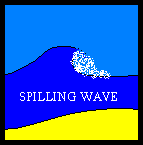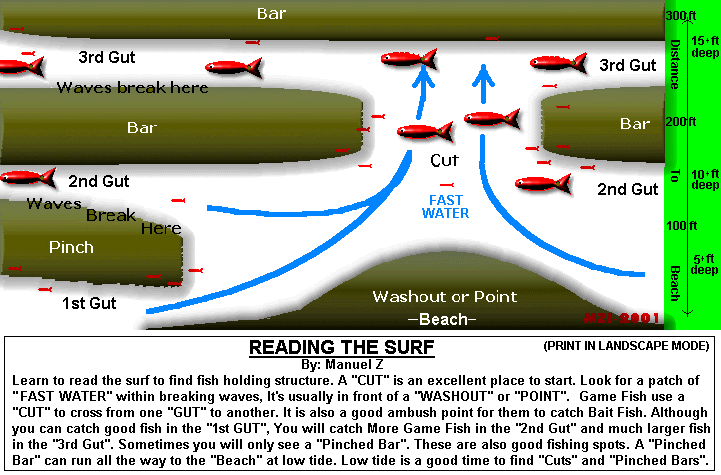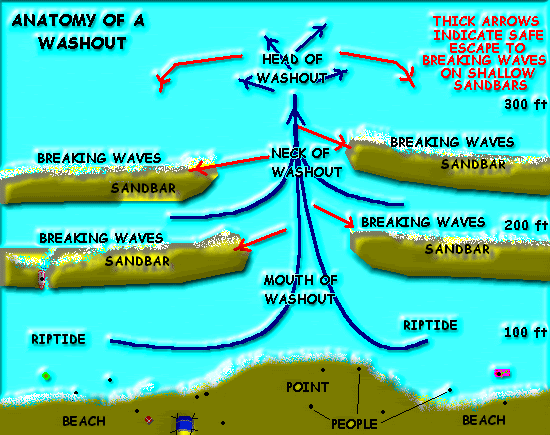This helped me, and I thought it might help others:
ANATOMY OF THE SURFBy: Manuel Z
Updated July 26, 2001
First of all, Not all beaches are routinely patrolled by Life Guards, Park Rangers or Game Wardens. Some beaches are much more dangerous than others. You must be responsible for all your own actions when you are in or around the Surf. Be aware of the Surf conditions to avoid a possible mishap. The information in this section will cover Waves and the effect different surfaces can have on them. Structure and where to find fish. what are Bars, Guts Washouts and Cuts. What are Undertow and Riptides. and most importantly... What to do if you get washed out into the ocean.
WAVESA wave is simply water moving along the surface of the ocean or any body of water for that matter. The waves we are concerned with occur only along a shoreline where water topples over itself along a sand bar this of course is the Surf.
HERE ARE THE THREE BASIC WAVES:SURGING WAVES: Occur on rocky shorelinesThis type of wave seldom if ever breaks as it approaches the shore. this is caused by deep water and is usually associated with Rocky shores, Jetties or Manmade Seawalls.
 SPILLING WAVES
SPILLING WAVES: Occur at any timeThis type of wave is a normal wave and occurs when a wave spills over upon itself above a sand bar. This is the wave most Swimmers, Surfers, and Boogie boarders are used to. once in a while this wave will create a tunnel effect called a "Tube" or "Pipe" by Surfers.
 PLUNGING WAVES
PLUNGING WAVES: Occur at High Tide or steep beachesThis type of wave is the most violent and dangerous wave. These waves can crash right up to the beach, dumping swimmers onto the sand or even knocking over unsuspecting beach combers.
 STRUCTUREBars, Guts, Cuts and Washouts
STRUCTUREBars, Guts, Cuts and Washouts
 UNDERTOW
UNDERTOWWhat is Undertow and what can it do
Undertow is the force of water underneath the surface which is flowing away from the beach, Although the water on the surface seems to be moving towards the beach, there is a strong surge of moving water below the surface which can sweep your feet right out from under you causing you to get washed out into the ocean.
WASHOUTSWhat is a Washout & What to do if you get caught in one.
 DO NOT PANIC - GO WITH THE FLOW
DO NOT PANIC - GO WITH THE FLOW If you happen to step off a sandbar into a cut, You have a good chance of getting washed out away from the beach by the UNDERTOW. If this happens,
look for BREAKING WAVES (White water)... remember, Waves only break on sandbars! If you can swim to one side, do so at a moderate pace,
you CAN NOT out swim the rushing water in the neck of a washout! and
you should NOT try to swim towards the beach. just try to stay afloat on your back, occasionally raising your arms to signal that you are OK. and wave back anyone trying to swim out to help you unless they have a flotation device or life vest.
A Washout can pull you 300 feet or farther away from the beach, This is not a problem if you
DO NOT PANIC! and remember to
SWIM TO BREAKING WAVES.

Here is a quick run-down of what is in the above drawing:
RIPTIDE: This is a cross current which flows from either left to right or right to left within a
GUT feeding the
MOUTH OF THE WASHOUT: where rushing water is forced through the
CUT where sand has been washed away from the the first and second
SANDBARS which are the high points in the ocean where the water is shallower, this causes
BREAKING WAVES which happen on the ocean side of sandbars near the
BEACH. People will be all along the beach and should stay clear of the
NECK OF THE WASHOUT which is the fast flowing water between the cut Sandbars, these lead out to the
HEAD OF THE WASHOUT where the flowing water slows and dissipates into the deep ocean approximately 300 to 400 feet

